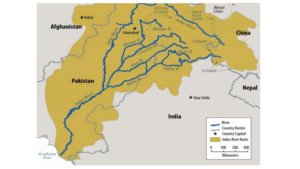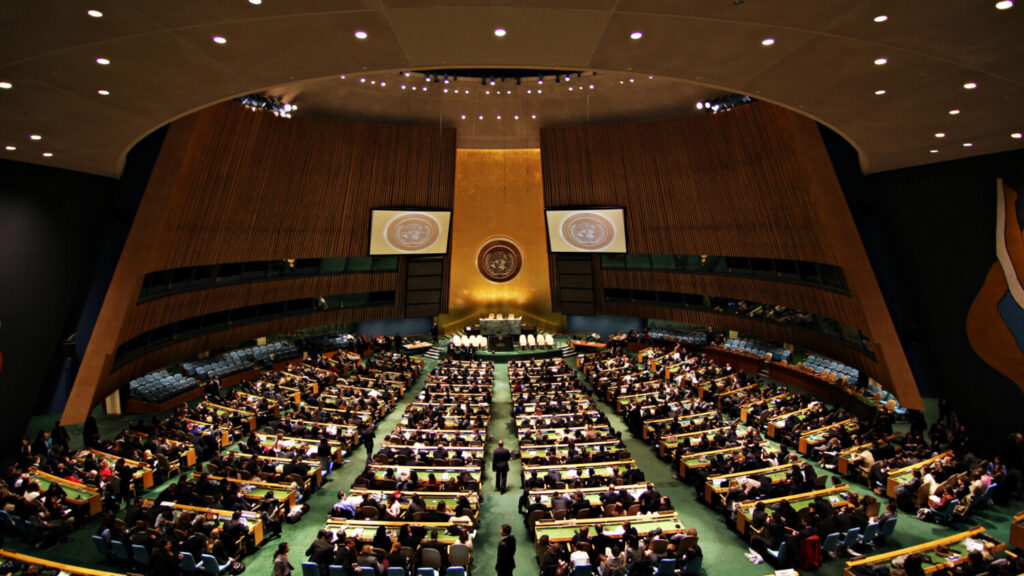A Geopolitical Analysis of Kashmir Part 2: An Essential Lifeline of Kashmir – Water
As explored in the previous article, Kashmir has several key geographic factors which contribute to its strategic and geopolitical significance. Among the most important aspects are its[1] rivers that provide water to millions and contribute to the socio-economic growth of the region.
With modern technology and manpower, the natural geography can be changed to the benefit or detriment of humans. The Kashmiri rivers provide agricultural growth in Pakistan, guaranteeing economic development, food security and hydraulic energy. However, the actual source of the rivers lies within India’s Jammu and Kashmir state. Pakistan has long prioritised the protection and flow of Kashmiri rivers downstream to ensure the continuation of its agricultural economy. The Indus Basin, the transboundary region encompassed by the Indus, Jhelum, Chenab and additional rivers and tributaries, cover over 70% of Pakistan’s land-based area, provide water to millions of hectares ideal for farmland.[2] According to the Food and Agricultural Organization (FAO), approximately 25% of Pakistan’s gross domestic product (GDP) comes from the agricultural sector, where nearly 38% of Pakistan’s labour force is employed to cultivate crops such as rice, wheat, sugarcane and cotton.[3] Kashmir thus provides vital water to Pakistan, thereby offering food security. This explains why both Punjabs are the breadbaskets of Pakistan and India.
For India, Kashmir’s water sources provide energy to its population in the region, and for agriculture in its Jammu and Kashmir state. [4] According to research, the region could produce approximately 20,000 megawatts.[5] In perspective, this could power between 10-40 million homes, depending on the electric consumption and type of power source needed. Yet, India has only been able to acquire 3,500 megawatts thus far. Thus, many policy initiatives in both the local Government of Jammu and Kashmir state and within New Delhi with a view to strengthening the economic opportunities through employment, improving energy-based security and reducing reliance on fossil fuels.

Given this context, if either India or Pakistan modified the river system to their advantage, it would likely be at the detriment of the other. This reinforces the argument why both sides have continued their unending struggle for control. And should either state engage in activities deemed to modify these water sources, it can be interpreted as a deliberate provocation to national interests. For example, Pakistan has on multiple occasions pursued means through military, covert, and ideological means, resulting in the 1965 Second Kashmir War through Operation Gibraltar, the 1999 Kargil Conflict, and supporting insurgencies to acquire strategic regions in Kashmir. The latter was recognised regarding past operations during recent interviews, one with the Defence Minister of Pakistan and another with the Chairman of Pakistan People’s Party, both expressing that Pakistan does not support and condemns terrorism under their current government.[6] In contrast, India has, during these conflicts, attempted through military operations and diplomatic means to reclaim territory. Despite terrorist incidents against India, India has received limited international support. For example, several states have not changed their perception of territorial claims for Jammu and Kashmir by India or Pakistan.
Hence, to avoid tensions between the two states, water-sharing treaties offer the possibility to maintain regional stability. The World Bank helped mediate between both countries to ratify the Indus Water Treaty in 1960, which governs the usage of the river systems, promoting cooperation and mechanisms to resolve disputes.[7] This was a milestone in building balance and mutual trust. However, the recent Pahalgam attacks by terrorists, killing 26 civilians in Kashmir, resulted in a strong response by India. This included the Indus Water Treaty being suspended, and will continue until the cross-border terrorism from Pakistan has stopped.[8] The Indian Government is considering accelerating and developing the hydroelectric infrastructure and dams for its interests. This will create a strategic chokehold on Pakistan by modifying the river systems. However, this cannot be done overnight, as a project this size would take up to a decade to take into effect and imply major financial, logistical, environmental, and human factors that need to be considered. Pakistan’s Government has stated that any efforts to change the flow of water as an act of war, and India also recognised that this could lead to military escalation. Third party intervention, such as through mediation will be vital to reinforce cooperation and legitimacy of the treaty. Both states on multiple occasions, whether related to water issues or other concerns, have resolved through bilateral discussions.
However, Pakistan’s Government faces a reality check that cross-border terrorism into India poses implications for its agricultural and food security. Should the Indian Government pursue its intentions to alter the Kashmiri rivers, Pakistan will necessarily have to demonstrate efforts to India on curbing terrorist organisations. India cannot modify the entire river system, and both Governments will need to address mutual security interests, as the Indus Water Treaty offers a key framework for cooperation amidst geopolitical tensions.
While the ceasefire following the April 2025 attack in Kashmir is still in effect, the suspended water treaty poses a longer-term challenge. A solution may be for Pakistan to apprehend the terrorists involved in the recent attacks, whilst India may want to reinstate the water treaty and focus on domestic infrastructural plans. But India’s strategic move to pressure Pakistan may also backfire, due to China planning to build the world’s largest dam on the Yarlung Tsangpo-Brahmaputra River in Tibet. [9] Thus, they will be on the receiving end as well. While not a signatory member of the Indus Water Treaty, Beijing holds the cards to further effect the Indo-Pakistan relations and policies. Hard and soft diplomacy will be the way forward to resolve these challenges in the foreseeable future.
Therefore, due to the importance of the Indus River system for both India and Pakistan, finding a diplomatic solution during this de-escalated situation is critical thus avoiding the potential loss of millions in revenue, reducing food insecurities and reducing the chance of a major conflict .Though not a signatory, China controls the Indus headwaters in Tibet. If tensions rise between India and China, Beijing could leverage its upstream position—either by withholding hydrological data or altering river flows—adding a new layer of complexity to the Indo-Pak dynamics. Unquestionably, terrorism and tackling terrorist organisations should be addressed first to prevent a potential water war between these two nuclear power states.
Reference:
[1] The Express Tribune, “Why an Independent Kashmir is not good news for Pakistan and India”, Dr. Ali Hashim, 18 September 2017, URL: https://tribune.com.pk/article/57075/why-an-independent-kashmir-is-not-good-news-for-both-pakistan-and-india
[2] Times Agriculture, “Agriculture and Water Resources Situation in Pakistan”, 13 May 2022, URL: https://timesagriculture.com/agriculture-and-water-resources-situation-in-pakistan/?utm_source=chatgpt.com
[3] FAO, “FAO and Pakistan”, 2025, URL: https://www.fao.org/pakistan/our-office/pakistan-at-a-glance/en//?utm_source=chatgpt.com
[4] Climate Diplomacy, “Water conflict and cooperation between India and Pakistan” 2019, URL: https://climate-diplomacy.org/case-studies/water-conflict-and-cooperation-between-india-and-pakistan
[5] Kashmir Observer, “‘J&K Has 20k MW Hydropower Potential, only 3500 MW Tapped In 70 Yrs’”, KNO, 2 August 2023, URL: https://kashmirobserver.net/2023/08/02/jk-has-20k-mw-hydropower-potential-only-3500-mw-tapped-in-70-yrs/?utm_source=chatgpt.com
[6] Sky News, “Pakistan warns Kashmir row could lead to all-out-war with India – The World with Yalda Hakim” URL: https://www.youtube.com/watch?v=12w8UO0nufE
[7] World Bank Group, ‘Fact Sheet: The Indus Waters Treaty 1960 and the Role of the World Bank’ 11 June 2018, URL: https://www.worldbank.org/en/region/sar/brief/fact-sheet-the-indus-waters-treaty-1960-and-the-world-bank
[8] Reuters, “India weighs plan to slash Pakistan water supply with new Indus river project” By Sarita Chaganti Singh, Krishna N. Das, Aftab Ahmed, Charlotte Greenfield and Ariba Shahid, 16 May 2025, URL: https://www.reuters.com/world/asia-pacific/india-weighs-plan-slash-pakistan-water-supply-with-new-indus-river-project-2025-05-16/
[9] Asia Times, “China’s plan for world’s biggest dam a mega-disaster for India” Sara Sheikh, 5 April 2025, URL: https://asiatimes.com/2025/04/chinas-plan-for-worlds-biggest-dam-a-mega-disaster-for-india/#



